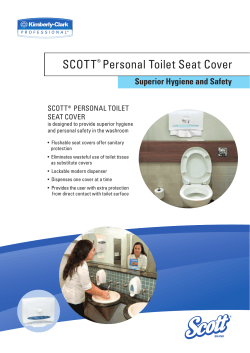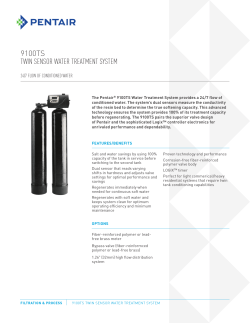
THE FACTS ABOUT LEAKS WATER TOPICS IN OUR COMMUNITY: QUICK FACTS
WATER TOPICS IN OUR COMMUNITY: THE FACTS ABOUT LEAKS QUICK FACTS • Drip, drip, drip… A slow leak or drip (two drips per minute) from your hose, faucet or toilet, can waste: • .28 gallons per day • 8.65 gallons per month CAN LEAKS REALLY WASTE A LOT OF WATER? Can leaks really waste a lot of water? Leaks in your home or business can be costly–for you and for our community’s water supply. At Truckee Meadows Water Authority (TMWA), we encourage all of our customers to use the water you need, but please don’t waste it. Leaks can be a huge water waster and may increase your water bill. TMWA’s staff learns of leaks at customers’ homes and businesses every day. Here are some examples: • 105.30 gallons per year • Periodically: Check all faucets for drips. Replace any worn and leaking washers, gaskets, pipes or defective fixtures. Also, check for leaks on outside faucets. • A Donner Springs customer, who has a non-billing meter, was losing between 800,000 and 900,000 gallons per month for approximately four months. The water was leaking from a yard line and the water never surfaced. The rate of the leak was approximately 20 gallons per minute. If this customer were on a metered rate, the four water bills would have totaled more than $10,000, instead of $280 on the flat rate. TMWA conservation staff notified the customer, and the leak was fixed. • Did you know? Flushing a toilet can use up to seven gallons of water. Installing a low-flow toilet, which uses only 1.6 gallons per flush, can save up to five gallons per flush. • There’s also the story of another customer whose non-billing meter at her home registered 300,000 gallons a month, compared to the average usage of 6,000 gallons a month for a family of four during the winter time. Again, the customer did not see puddles or running water anywhere. The leak was under a large deck in the back yard and was not immediately noticeable. • TMWA recently documented a toilet leak at 19 gallons every five minutes, or 164,000 gallons in a month. Contrary to what some might think, it is entirely possible for a running toilet to lose that much, or significantly more. • Another TMWA customer recently discovered a toilet leak of 144,000 gallons per month. Average inside water for a family of four is 6,000 gallons per month. That costs over $350 in unnecessary water usage charges for just one month. • Wow! The highest toilet leak documented by TMWA is 240,000 gallons in one month— that’s enough water to fill 75 construction water trucks, or more than 2.5 construction water trucks every day! • To learn more about workshops addressing this topic, visit: www.tmwa.com/calendar • For more information on repairing leaks visit: www.tmwa.com/conservation/ leaks If your home or business has a meter, the amount of water used is shown on your bill. The TMWA billing staff reviews bills for extraordinarily high water use and will attempt to notify the customer should we see it. Why does TMWA focus on toilet leaks? Running toilets account for the vast majority of leaks found inside the home. While nobody wants to admit their toilet leaks, it is estimated that about 20% of all toilets leak slightly. A toilet leaking one gallon every five minutes will cause the usage to jump by more than 8,500 gallons in a month—and you may never hear the water running. How do I check my toilet for leaks? To check for a leak, put a little food coloring in your toilet tank. If, without flushing, the coloring begins to appear in the bowl, you have a leak. To fix the leak, try replacing the flapper gasket, adjusting or replacing the flush valve, or call a plumber. Truckee Meadows Water Authority | 1355 Capital Blvd. | Reno, NV 89502 | 775.834.8080 | www.tmwa.com About TMWA: Truckee Meadows Water Authority (TMWA) is a not-forprofit water utility, overseen by elected officials from Reno, Sparks and Washoe County. TMWA employs a highly skilled team who ensure the treatment, delivery and availability of high-quality drinking water around the clock for more than 330,000 residents of the Truckee Meadows. About this series: Water Topics in Our Community is a series of papers designed to provide the citizens of the Truckee Meadows information about key water topics in this region. To access all of the papers, go to www.tmwa.com/topics. About TMWA’s Board of Directors: The TMWA Board welcomes you to attend and comment at any board meeting. Meeting schedules are posted at www.tmwa.com/meetings. To send a question to the Board, visit us online at www.tmwa.com/comment. Questions or feedback? We’d like to hear from you. Please call our Community Communications line with any remaining questions you have on this topic or other water topics. The number is (775) 834-8290. How do I know if I have a leak? Look to your water meter. The following instructions are for reading your meter to determine if you have a leak. Take care when lifting the box lid to prevent injury to yourself or damage to the meter or meter lid. 1. Find your meter. It is often located in front of your house or your neighbor’s, in the sidewalk. 2. Remove the meter box lid. Note: some meter box lids have a “flip lid” in the center. If so, open this instead of removing the entire lid. 3. Verify the meter number to ensure you are checking service for your residence. The meter number on your billing statement should match the one stamped on the meter. 4. Lift the meter cap lid over the lens and position yourself to read the meter. Locate the dial on the meter face. This dial monitors water use in thousands of gallons. If the flow indicator or needle moves while all water devices inside and outside the home are shut off, water is flowing through the meter and you have a leak. 5. When you are finished, close the meter cap to prevent damage to the lens. Replace the meter box lid, taking care not to damage the meter or lid. How do I find a hidden leak? If your meter shows water flowing through it, yet all of your water faucets are turned off, you probably have a hidden leak. If you suspect you have a phantom water waster on your property, follow these tips to find the leak. First, make sure no water is being used inside or outside of your home. Then locating a leak is a process of elimination. Check your toilets: Shut off one toilet at a time at the wall. The shut-off valve is usually located on or near the wall behind the toilet bowl. In between each shut off, go out to the water meter and check your flow indicator. If the small, red flow indicator is moving, that toilet is not the problem. Something else is causing the leak. If the flow indicator stopped moving, that means the toilet shut off is the culprit. Check your sprinkler system: Shut off the anti-siphon valve that serves your sprinkler system. Check the red flow indicator at the water meter. If the flow indicator stopped moving, the sprinkler system is the problem. Check your main service line: First, you need to find your water shutoff valve. This is usually in your front yard near the sewer riser cap, in your garage or near your water softener unit. Shut off the valve, cutting off all water to your home, and go in the house and turn on a faucet to make sure the water is off. Check the red flow indicator at the meter. If it is moving, the leak is between the shut-off valve and the water meter. Now what? First, close the water meter cap to prevent damage to the lens and replace the meter box lid. If you are not able to find the leak, you should call a professional plumber to locate and fix the leak(s). If you find a simple leak like your toilet flapper or kitchen faucet, you may want to fix the problem yourself. Mailing address: P.O. Box 30013 Reno, NV 89520-3013 Main line: (775) 834-8080 www.tmwa.com Document date: 5/21/12 The case for hidden leaks: The bottom line is that while TMWA is committed to helping every customer find the source of his or her water leak, it is not always easily identifiable. In these cases, a plumber or other industry professional may be best equipped to help.
© Copyright 2025





















